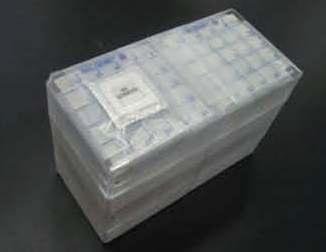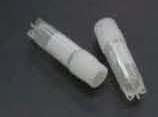- completed
[Stem Cells]
Study on the Effect of Space Environment to Embryonic Stem Cells to Their Development
- Biology and Biotechnology
ISS Science for Everyone
SCIENCE OBJECTIVES FOR EVERYONE
Stem Cells is an investigation that uses embryonic mouse stem cells to study the effects of the space environment on their DNA, chromosomes, and on their development into adult mice after return to Earth. Frozen stem cells are placed in the Kibo module for periods ranging from 6 to 36 months, and then returned to Earth where scientists microinject them into 8-cell mouse embryos that are implanted into female mice. Investigators also look for double-strand DNA breaks and chromosome aberrations caused from exposure to space radiation.
Experiment Description
RESEARCH OVERVIEW
- Space contains higher levels of cosmic radiation, including Galactic Cosmic Rays (GCR) and Solar Particle Events (SPE). Therefore,it is extremely important to estimate their effects on organisms in order to predict and develop countermeasures for the human body to protect against those influences. In the future, there is a great possibility of reproduction and development in space, and these radiation events can pose serious problems during a long duration stay in space.
- The survival ratios of Embryonic Stem (ES) cells to space radiation are analyzed using colony formation. At the same time, researchers can also detect DNA double-strand breaks, and chromosome aberrations of ES cells can be assessed using antibodies against the phosphorylated histone, H2AX, and in situ hybridization techniques. From these experiments researchers can estimate the extent of space radiation onboard ISS. The ES cells are microinjected and cultured in vitro, and their development can be followed by time-lapse microscopy. The surviving chimeric embryos are implanted into a pseudo-pregnant mouse uterus, and their birth is examined. From these experiments, researchers are able to detect the influence of space radiation through subsequent generations.
- Data obtained from the mouse ES cells is extrapolated to human cells and embryos, and can be used for studying the protection of the human body for long duration missions in space.
DESCRIPTION
With the completion of the Japanese Experiment Module “Kibo”, long duration manned missions on board the International Space Station are now a reality. The space environment contains many types of ionizing radiation, so it is extremely important to estimate the effects of radiation on organisms in order to predict and develop countermeasures for the human body from those influences. Also, these radiation events could pose problems for future reproduction and development in organisms during long duration missions in space.
Because it is difficult to breed animals in space to examine the influence of space radiation and micro-gravity for long periods of time, this experiment exposes ES cells to the space environment and studies the effects. The ES cells for this experiment are frozen on Earth, and stored in a dedicated Stem Cell Sample Case, with a Bio Dosimeter to measure radiation. After the ES cells are returned to the ground, the survival rate of the ES cells exposed to space radiation is analyzed using colony formation. Also, researchers are able to also detect DNA double-strand breaks and chromosome aberrations in the ES cells, and also quantify the cells after exposure to space radiation. Analysis techniques include using antibodies against phosphorylated H2AX histone, and in situ hybridization techniques. From these experiments researchers can estimate the extent of space radiation on board ISS.
Later, the ES cells are microinjected, cultured in vitro, and their development followed by time-lapse microscopy. The surviving chimeric embryos are then implanted into a pseudo-pregnant mouse uterus and their birth examined. From these experiments, the influence of the space radiation through subsequent generations can be assessed.
Media Gallery



Applications
SPACE APPLICATIONS
The space environment poses severe radiation hazards from galactic cosmic rays, solar energetic particles, and other sources, including secondary neutrons from the body itself. Results from the Stem Cells investigation can help scientists understand extent of influence to the human body and its development, as well as mechanisms of DNA repair, in humans and other animals, against space radiation.
EARTH APPLICATIONS
Radiation also is a low-level hazard on Earth from natural and manmade sources. Results from the Stem Cells investigation can help scientists assess the safety of human body to such hazards, and also that of long-term management and conservation of stem cells in regenerative medicine.
Operations
OPERATIONAL REQUIREMENTS AND PROTOCOLS
Cold Stowage requirements: Stem Cells Sample Case and Bio Dosimeter stored at -95°C from launch to recovery. Temperature data to be provided during Ascent, On-orbit operations (once a week), and Descent. Data taken at 5 minute intervals is preferable. Please stow Bio Dosimeter (not attached Stem Cells Sample Case) in Vial bag (3 X 5 mesh bag) on orbit.
Five Stem Cells Sample Cases containing Mouse embryonic stem cells are launched at -95°C on SpaceX. Bio Dosimeters (PADLES packages) are launched and returned regularly by SpaceX, or any vehicle for long-term radiation measurement. Stem Cells Sample Cases and Bio Dosimeters should be stored at -95°C in MELFI until return from orbit (for about (1) 6 month, (2) 12 months, (3) 18 months, (4) 24 months, (5) 36 months). Stem Cells Sample Cases should be returned one by one at -95°C.
Publications
PRINCIPAL INVESTIGATOR(S)
MORITA Takashi [Osaka City University]
Unless specified otherwise, rights to all images belong to ©JAXA



